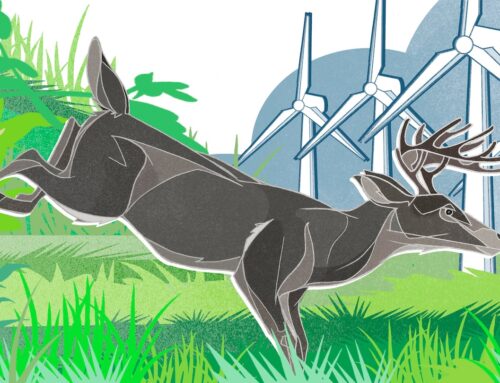Feds ducked protections for Great Salt Lake bird, environmental groups allege
October 1, 2025
Environmental advocates and artists continue to hope a pint-sized bird will force bold and swift action to save the Great Salt Lake.
Community organizers, along with famed writer Terry Tempest Williams and poet Nan Seymour, called on the U.S. Department of Interior to list the Wilson’s phalarope as a threatened species back in March 2024. The move was meant to bring federal intervention and protect the birds from extinction — and by extension, preserve the lake-based habitat and ecosystem on which they depend.
After getting no response from both the Biden and Trump administrations, however, the groups are now turning to the courts.
“The stakes have never been higher,” said Deeda Seed, a senior campaigner for the Center for Biological Diversity. “This is absolutely the most urgent crisis Utah faces.”
(Francisco Kjolseth | The Salt Lake Tribune) Deeda Seed, with the Center for Biological Diversity, is joined by local organizations and community members for a rally and press conference on the souther edge of the Great Salt Lake on Wednesday, Oct. 1, 2025, to announce a federal lawsuit to protect Wilson’s phalarope, a migratory bird species whose fate is inextricably linked to the embattled saline lake.
The organization escalated the petition to protect phalaropes by filing a notice of intent to sue the federal government Wednesday.
By failing to take action, the notice asserts, Interior and the U.S. Fish and Wildlife Service have violated the Endangered Species Act.
“The Endangered Species Act is an act of beauty,” Tempest Williams said at a news conference and rally in support of the litigation. “It’s an act of compassion, and it’s an act of humility.”
Phalaropes follow a long migration path every year, flying from Canada to Argentina and Chile. Salty lakes and marshes in the Western United States provide a much-needed stopover for the shorebirds to rest and refuel. But those saline systems are disappearing due to human water use.
The birds double their body weight by dining on brine shrimp and bugs at the Great Salt Lake each year. But if those important food sources disappear as the lake shrinks and its ecosystem collapses, phalarope populations could implode.
“As a child, we would come out and look when the phalaropes arrived, my grandmother and I, and it looked like feathered water,” Tempest Williams said. “Now you go out to the causeway at Antelope Island and it’s puddles.”
(Francisco Kjolseth | The Salt Lake Tribune) Author Terry Tempest Williams is interviewed as local organizations and community members hold a rally and press conference on the souther edge of the Great Salt Lake on Wednesday, Oct. 1, 2025, to announce a federal lawsuit to protect Wilson’s phalarope, a migratory bird species whose fate is inextricably linked to the embattled saline lake.
As of Wednesday, the lake’s south arm sat at 4,191 feet above sea level — just 2.5 feet higher than its record-low elevation set in late 2022.
“We are literally one dry winter away from where we were in 2022,” Seed said, “when we were seeing the food web start to collapse.”
Utah lawmakers overhauled the state’s pioneer-era water law in recent years so water right holders can lease or permanently donate water to the lake. The Church of Jesus Christ of Latter-day Saints, Rio Tinto Kennecott, Jordan Valley Water Conservancy District and others provided some of the first water the lake could legally call its own starting in 2021.
As of July, that dedicated water amounted to 202,543 acre-feet, according to information available from the Utah Division of Water Rights. But that only represents about 2% of the water currently in the lake, and a drop of what it needs to rise another seven feet in order to reach a minimum healthy elevation.
Mike Maxwell with LDS Earth Stewardship noted religious scripture calls for care and protection of the earth and its resources.
“The [LDS] Church itself has been trying to escalate some of that narrative a little bit more as of late,” Maxwell said. “… [But] I wouldn’t be here if they were doing enough.”
Wednesday’s event was held on the south shore of the Great Salt Lake near Saltair, and featured a vast expanse of drying playa as a backdrop.
“Yes, this lawsuit is intended to preserve wildlife,” said Jonny Vasic, executive director of Utah Physicians for a Healthy Environment. “But on a deeper level, this petition is also intended to preserve a safe and livable environment for the 2 million people who live along the Wasatch Front.”
(Francisco Kjolseth | The Salt Lake Tribune) Local organizations and community members hold a rally and press conference on the southern edge of the Great Salt Lake on Wednesday, Oct. 1, 2025, to announce a federal lawsuit to protect Wilson’s phalarope, a migratory bird species whose fate is inextricably linked to the embattled saline lake.
While a warming climate and drought have contributed to water shortages throughout the West, the Great Salt Lake’s decline is almost entirely human caused. Water is diverted from its tributary rivers to water lawns, grow food and feed industry.
Lake advocates worry that short-term mitigation efforts, like sealing off a rock-filled causeway bisecting the lake to protect its southern half from spiking salinity, ignore the long-term public health fallout of dust blowing from the desiccated lakebed.
More than 800 square miles of playa currently sit exposed.
A class of Emerson Elementary sixth-grade students and Utah Youth for Environmental Solutions also spoke and sang songs at the rally in support of listing Wilson’s phalaropes.
(Francisco Kjolseth | The Salt Lake Tribune) Poet Nan Seymour teaches a song to Emerson Elementary sixth graders as they participate in a rally at the Great Salt Lake to announce a federal lawsuit to protect Wilson’s phalarope, a migratory bird species whose fate is inextricably linked to the embattled saline lake, Wednesday, Oct. 1, 2025.
“When you change-makers, politicians, the everyday voter, choose to save something smaller than yourselves,” said 17-year-old Adalayde Scott, “you are showing me that you want to save me and my future too.”
Last week, Gov. Spencer Cox, House Speaker Mike Schultz and Senate President Stuart Adams announced a $200 million philanthropic donation from the business community and nonprofit Ducks Unlimited, along with a plan to raise the lake to a healthy elevation by the 2034 Winter Olympics.
Lake advocates at Wednesday’s event praised the initiative as a positive step in the right direction. But they warned the timeline neglected the urgency at stake. Migrating birds that depend on the lake’s ecosystem are already starting to feel the effects of its decline, they said.
“That’s too long,” Seed said. “We don’t have 10 years. The birds don’t have 10 years.”
This article is published through The Great Salt Lake Collaborative, a partnership of news, education and media organizations that aims to inform readers about the Great Salt Lake.
Search
RECENT PRESS RELEASES
Related Post




